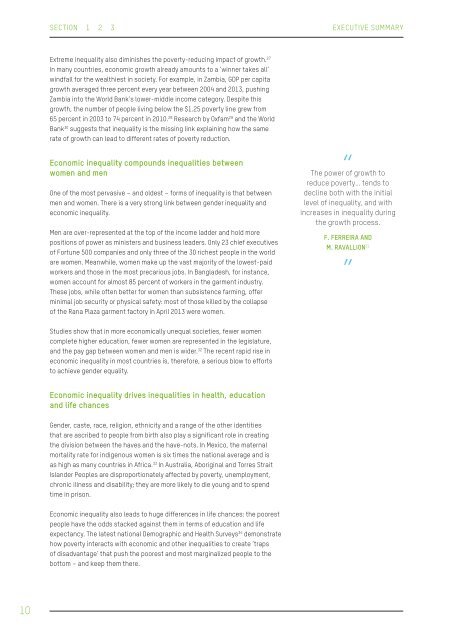1FW2e8F
1FW2e8F
1FW2e8F
Create successful ePaper yourself
Turn your PDF publications into a flip-book with our unique Google optimized e-Paper software.
SECTION 1 2 3 EXECUTIVE SUMMARY<br />
Extreme inequality also diminishes the poverty-reducing impact of growth. 27<br />
In many countries, economic growth already amounts to a ‘winner takes all’<br />
windfall for the wealthiest in society. For example, in Zambia, GDP per capita<br />
growth averaged three percent every year between 2004 and 2013, pushing<br />
Zambia into the World Bank’s lower-middle income category. Despite this<br />
growth, the number of people living below the $1.25 poverty line grew from<br />
65 percent in 2003 to 74 percent in 2010. 28 Research by Oxfam 29 and the World<br />
Bank 30 suggests that inequality is the missing link explaining how the same<br />
rate of growth can lead to different rates of poverty reduction.<br />
Economic inequality compounds inequalities between<br />
women and men<br />
One of the most pervasive – and oldest – forms of inequality is that between<br />
men and women. There is a very strong link between gender inequality and<br />
economic inequality.<br />
Men are over-represented at the top of the income ladder and hold more<br />
positions of power as ministers and business leaders. Only 23 chief executives<br />
of Fortune 500 companies and only three of the 30 richest people in the world<br />
are women. Meanwhile, women make up the vast majority of the lowest-paid<br />
workers and those in the most precarious jobs. In Bangladesh, for instance,<br />
women account for almost 85 percent of workers in the garment industry.<br />
These jobs, while often better for women than subsistence farming, offer<br />
minimal job security or physical safety: most of those killed by the collapse<br />
of the Rana Plaza garment factory in April 2013 were women.<br />
“<br />
The power of growth to<br />
reduce poverty… tends to<br />
decline both with the initial<br />
level of inequality, and with<br />
increases in inequality during<br />
the growth process.<br />
F. FERREIRA AND<br />
M. RAVALLION 31<br />
”<br />
Studies show that in more economically unequal societies, fewer women<br />
complete higher education, fewer women are represented in the legislature,<br />
and the pay gap between women and men is wider. 32 The recent rapid rise in<br />
economic inequality in most countries is, therefore, a serious blow to efforts<br />
to achieve gender equality.<br />
Economic inequality drives inequalities in health, education<br />
and life chances<br />
Gender, caste, race, religion, ethnicity and a range of the other identities<br />
that are ascribed to people from birth also play a significant role in creating<br />
the division between the haves and the have-nots. In Mexico, the maternal<br />
mortality rate for indigenous women is six times the national average and is<br />
as high as many countries in Africa. 33 In Australia, Aboriginal and Torres Strait<br />
Islander Peoples are disproportionately affected by poverty, unemployment,<br />
chronic illness and disability; they are more likely to die young and to spend<br />
time in prison.<br />
Economic inequality also leads to huge differences in life chances: the poorest<br />
people have the odds stacked against them in terms of education and life<br />
expectancy. The latest national Demographic and Health Surveys 34 demonstrate<br />
how poverty interacts with economic and other inequalities to create ‘traps<br />
of disadvantage’ that push the poorest and most marginalized people to the<br />
bottom – and keep them there.<br />
10


